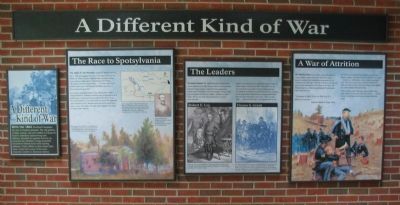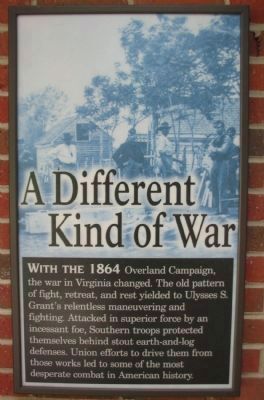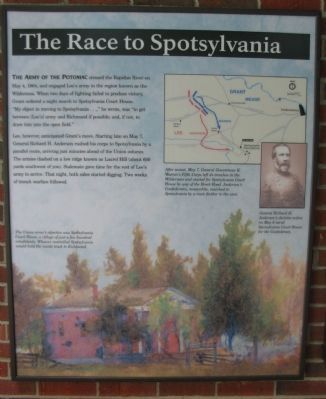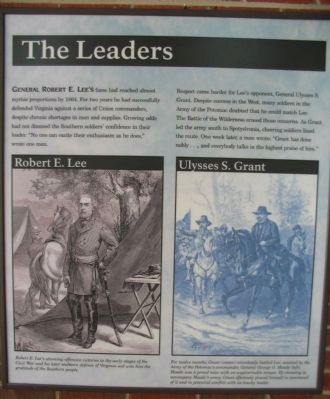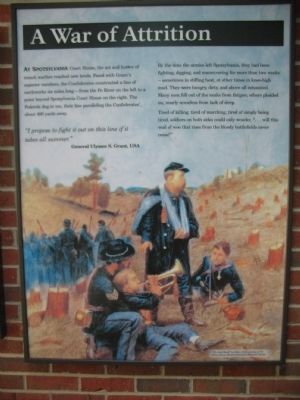Near Spotsylvania Courthouse in Spotsylvania County, Virginia — The American South (Mid-Atlantic)
A Different Kind of War
Spotsylvania Exhibit Shelter
— South Wall —
Inscription.
A Different Kind of War
With the 1864 Overland Campaign, the war in Virginia changed. The old pattern of fight, retreat, and rest yielded to Ulysses S. Grant's relentless maneuvering and fighting. Attacked in superior force by an incessant foe, Southern troops protected themselves behind stout earth-and-log defenses. Union efforts to drive them from those works led to some of the most desperate combat in American history.
The Race to Spotsylvania
The Army of the Potomac crossed the Rapidan River on May 4, 1864, and engaged Lee's army in the region known as the Wilderness. When two days of fighting failed to produce victory, Grant ordered a night march to Spotsylvania Court House. "My object in moving to Spotsylvania...,"he wrote, was "to get between [Lee's] army and Richmond if possible, and, if not to draw him into the open field.
Lee, however, anticipated Grant's move. Starting late on May 7, General Richard H. Anderson rushed his corps to Spotsylvania by a parallel route, arriving just minutes ahead of the Union column. The armies clashed on a low ridge known as Laurel Hill (about 600 yards southwest of you). Stalemate gave time for the rest of Lee's army to arrive. That night, both sides started digging. Two weeks of trench warfare followed.
The Leaders
General Robert E. Lee's fame had reached almost mythic properties by 1864. For two years he had successfully defended Virginia against a series of Union commanders, despite chronic shortages of men and supplies. Growing odds had not dimmed the Southern soldiers' confidence in their leader. "No one can excite their enthusiasm as he does," wrote one man.
A War of Attrition
At Spotsylvania Court House, the art and horror of trench warfare reached new levels. Faced with Grant's superior numbers, the Confederates constructed a line of earthworks six miles long - from the Po River on the left to a point beyond Spotsylvania Court House on the right. The Federals dug in too, their line paralleling the Confederates', about 400 yards away.
"I propose to fight it out on this line if it takes all summer."
General Ulysses S. Grant, USA
By the time the armies left Spotsylvania, they had been fighting, digging, and maneuvering for more than two weeks - sometimes in stifling heat, at other times in knee-high mud. They were hungry, dirty, and above all exhausted. Many men fell out of the ranks from fatigue; others plodded on, nearly senseless from lack of sleep.
Tired of killing, tired of marching, tired of simply being tired, soldiers on both sides could only wonder, "...will this wail of woe that rises from the bloody battlefields never cease?"
Topics and series. This historical marker is listed in this topic list: War, US Civil. In addition, it is included in the Former U.S. Presidents: #18 Ulysses S. Grant series list. A significant historical month for this entry is May 1906.
Location. 38° 13.146′ N, 77° 36.861′ W. Marker is near Spotsylvania Courthouse, Virginia, in Spotsylvania County. Marker is on Grant Drive, 0.1 miles north of Brock Road (County Route 613), on the left when traveling north. Located at stop one (The Exhibit Shelter) on the driving tour of Spotsylvania Battlefield unit of the Fredericksburg and Spotsylvania National Military Park. Touch for map. Marker is at or near this postal address: 9550 Grant Dr, Spotsylvania VA 22553, United States of America. Touch for directions.
Other nearby markers. At least 8 other markers are within walking distance of this marker. Testing the Line: May 8-10 (here, next to this marker); No Turning Back (here, next to this marker); The Battle of Spotsylvania (here, next to this marker); Spotsylvania Court House (here, next to this marker); Grant Finds an Opening: May 12 (a few steps from this marker); The Death of Sedgwick (about 300 feet away, measured in a direct line); Spotsylvania Campaign (about 400 feet away); a different marker also named Spotsylvania Campaign (about 400 feet away). Touch for a list and map of all markers in Spotsylvania Courthouse.
More about this marker. The background of A Different Kind of War panel is a group of soldiers on burial detail.
The Race to Spotsylvania panel uses a background using a depiction of Spotsylvania Courthouse, The Union army's objective was Spotsylvania Court House, a village of just a few hundred inhabitants. Whoever controlled Spotsylvania would hold the inside track in Richmond. A map in the upper right shows the route the armies took to arrive at the battlefield, After sunset, May 7, General Gouverneur K. Warren's Fifth Corps left its trenches in the Wilderness and started for Spotsylvania Court House by way of the Brock Road. Anderson's Confederates meanwhile, marched to Spotsylvania by a route farther to the west. Below the map is a portrait of Anderson captioned, General Richard H. Anderson's decisive action on May 8 saved Spotsylvania Court House for the Confederacy.
The The Leaders panel contains illustrations of the two generals. Robert E. Lee's stunning offensive victories in the early stages of the Civil War and his later stubborn defense of Virginia soil won him the gratitude of the Southern people. Under a drawing of Generals Grant and Mead conferring, For twelve months Grant (center) relentlessly battled Lee, assisted by the Army of the Potomac's commander, General George G. Meade (left). Meade was a proud man with an ungovernable temper. By choosing to accompany Meade's army, Grant effectively placed himself in command of it and in potential conflict with its touchy leader.
The background of the A War of Attrition panel is a painting titled The Last Recall" by Julian Scott, courtesy of the Drake House Museum / Plainfield Historical Society.
Also see . . . Spotsylvania Battlefield Exhibit Shelter. National Park Service website entry (Submitted on December 6, 2022, by Larry Gertner of New York, New York.)
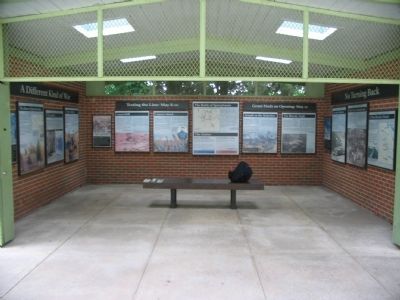
Photographed By Craig Swain
6. The Spotsylvania Exhibit Shelter
To the left is the south wall, with the A Different Kind of War marker. In the center are the Testing the Line: May 8-10, The Battle of Spotsylvania, and Grant Finds and Opening: May 12 markers along the west wall. To the right is the north wall with No Turning Back.
Credits. This page was last revised on December 6, 2022. It was originally submitted on August 25, 2008, by Craig Swain of Leesburg, Virginia. This page has been viewed 1,317 times since then and 19 times this year. Photos: 1, 2, 3, 4, 5. submitted on August 25, 2008, by Craig Swain of Leesburg, Virginia. 6. submitted on August 24, 2008, by Craig Swain of Leesburg, Virginia.
